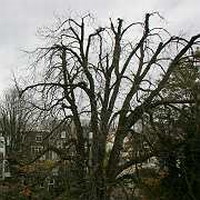Anne Frank's tree may be saved
Anne Frank's chestnut tree won a reprieve from the ax when a judge ordered the city to reconsider whether the diseased tree can be saved.

Judge Jurjen Bade adjourned a hearing and took witnesses and court officials with him to personally inspect the tree, watching as experts tapped its trunk to point out the rotten wood afflicted by fungus.
He listened to experts from both sides, and looked to see what might be crushed if it fell, including the nearby Anne Frank House museum, which includes the apartment where the Jewish teenager and her family hid from the Nazis for 25 months during World War II.
Anne Frank referred to the tree several times in her diary as a comfort to her while she was confined in the concealed apartment adjacent to the courtyard where the tree stands. She could see it through the attic skylight, the only window that was not blacked out.
The Amsterdam city ruled last year that the tree, estimated to be 150 to 170 years old, was in danger of toppling and causing serious injury or damage. Conservationists said, however, it was strong enough to withstand a storm and could be saved. Last week, the city issued its order to fell the tree.
Reconvening in his courtroom after the inspection, Bade ruled that the city had given insufficient consideration to alternative plans, such as anchoring the tree with cables. He said it had failed to prove the tree was an imminent threat.
Felling it would be "a last resort," he said, and told the city to meet with conservationists to find a solution. It was to have been cut down Wednesday at dawn.
In testimony earlier Tuesday, the Netherlands' Trees Institute argued to save the tree.
"This is a monumental tree of unusual cultural and historical value," Institute spokesman Edwin Koot testified. "It's a symbol of freedom all over the world and it summons forth a lot of emotion, as you can see."
The Anne Frank House, which had remained neutral until Tuesday, told the judge it favored cutting the tree, out of concern for the safety of the building and the hundreds of thousands of people who visit it each year.
Museum director Hans Westra said if the tree remains standing he would take legal action to ensure that the owner of the building where the tree stands, Henric Pommes, is held liable in case of injury or damage.
The museum already has taken grafts and plans to replace the tree with a sapling from the original.
"We would rather have a young living tree that will be 10 meters tall in 10 years," Westra said.
The Frank family was arrested in August 1944. Anne died in the Bergen-Belsen concentration camp eight months later, but her diary was rescued and has been read by millions.
Subscribe to Pravda.Ru Telegram channel, Facebook, RSS!




